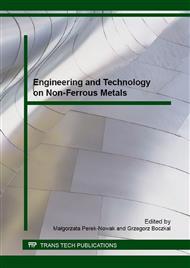p.220
p.226
p.239
p.245
p.252
p.259
p.265
p.270
p.276
The Influence of Process Parameters on Microstructure and Mechanical Properties of PM Al+4 wt. %Cu Alloy
Abstract:
Attempts have been made to describe the influence of the process parameters, such as compaction pressure and sintering atmosphere on the microstructure and properties of PM Al4Cu alloy. Homogenous mixtures of Al4Cu elemental powders were achieved by tumbling powders for 30 minutes in the Turbula T2F mixer. The powders were subsequently cold compacted under pressures of: 200MPa, 300MPa and 400MPa in a rigid die on a single action press. The green compacts were sintered in two different atmosphere - nitrogen and vacuum at 600°C for one hour. After that, the samples sintered in nitrogen atmosphere were re-pressed and re-sintered (2p2s) under the same conditions. The green compact and as-sintered densities were measured using the geometric method. Additionally, the Brinell hardness and the bending strength in three point bend test were determined. The microstructure of the samples was also analyzed using both the light microscopy (LM) and scanning electron microscopy (SEM).The obtained results show, that optimal pressing pressure is 300MPa. Increasing pressure to 400 MPa has not a substantial effect on increase of the final sample density. Therefore applying higher compaction pressure (over 300MPa), from the economical point of view, is unnecessary.
Info:
Periodical:
Pages:
252-258
Citation:
Online since:
February 2016
Authors:
Keywords:
Price:
Сopyright:
© 2016 Trans Tech Publications Ltd. All Rights Reserved
Share:
Citation:


